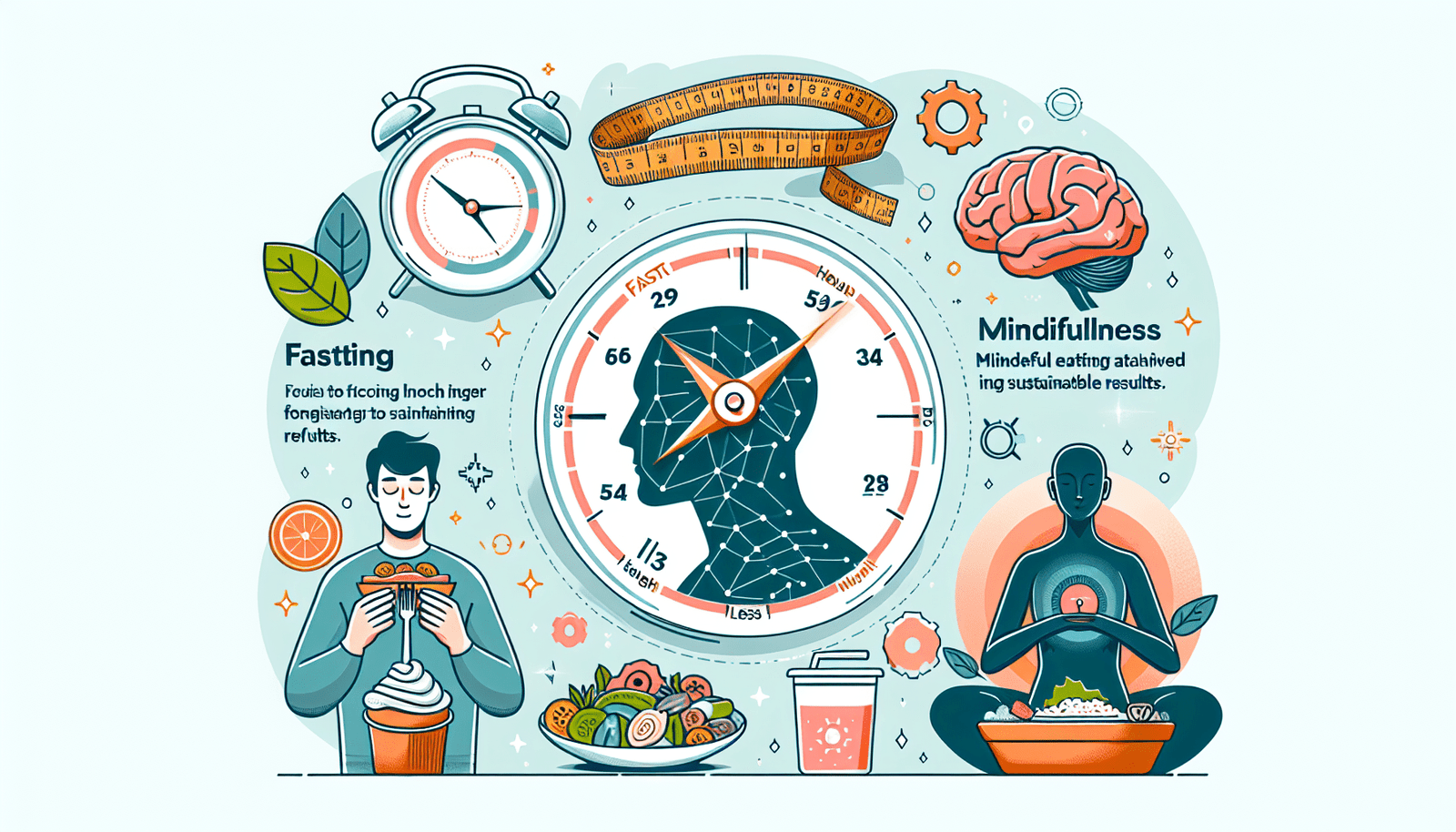So you’re looking to shed some pounds, huh? Well, look no further because we’ve got some fascinating insights for you. In this article, we explore the powerful combination of fasting and mindful eating in achieving your weight loss goals. It’s no secret that fasting has gained popularity in recent years, but have you considered how mindful eating could enhance your fasting journey? Join us as we unpack the role of mindfulness in not just what you eat, but also how you eat, and discover how this duo can revolutionize your weight loss journey.
The Benefits of Fasting
Fasting has gained popularity as a potential tool for weight loss and improved overall health. Several benefits are associated with incorporating fasting into your lifestyle, including improved insulin sensitivity, increased fat burning, reduced inflammation and oxidative stress, enhanced autophagy, and potential anti-aging effects.
Improved insulin sensitivity
One of the key benefits of fasting is its positive impact on insulin sensitivity. When you fast, your body is deprived of its main source of energy – glucose. As a result, your body starts to utilize stored glucose (glycogen) for energy. This process helps lower blood sugar levels and improves how your cells respond to insulin. By improving insulin sensitivity, fasting can help prevent or manage conditions such as type 2 diabetes and metabolic syndrome.
Increased fat burning
Fasting triggers a state of ketosis, where your body switches from using glucose as its primary fuel source to relying on stored fat for energy. During fasting, your body releases stored fat and breaks it down into ketones, which are then used as fuel. This increased reliance on fat for energy can lead to significant weight loss and a decrease in body fat percentage.
Reduced inflammation and oxidative stress
Inflammation and oxidative stress are underlying factors in many chronic diseases, such as heart disease, diabetes, and certain cancers. Fasting has been shown to reduce both inflammation and oxidative stress in the body. By reducing these harmful processes, fasting may contribute to improved overall health and a reduced risk of chronic disease.
Enhanced autophagy
Autophagy, a natural cellular process, involves the removal of damaged cells and cellular components. Fasting has been found to enhance autophagy, which can have several health benefits. By promoting cellular “clean-up,” fasting may help prevent the development of certain diseases and contribute to overall cell health.
Potential anti-aging effects
Emerging research suggests that fasting may have anti-aging effects. Caloric restriction, often achieved through fasting, has been shown to prolong lifespan and improve various biomarkers associated with aging. Fasting may improve the function of mitochondria, the energy-producing structures within cells, and reduce oxidative stress, both of which can contribute to the aging process.
Understanding Mindful Eating
To fully grasp the role of fasting in weight loss, it is essential to understand mindful eating. Mindful eating is a practice that involves becoming fully present and aware of the experience of eating. It emphasizes paying attention to internal cues of hunger and fullness, as well as savoring and thoroughly enjoying each bite. By practicing mindful eating, you can develop a healthier relationship with food and enhance your overall well-being.
Definition of mindful eating
Mindful eating involves purposefully engaging in the act of eating with full attention and without judgment. It means being fully present in the moment, observing the sensory experience of eating, and avoiding distractions. Mindful eating also includes acknowledging and responding to internal cues of hunger and fullness.
Principles of mindful eating
Several principles guide mindful eating:
Eating slowly: By consciously slowing down the pace of eating, you can fully experience and appreciate each bite, allowing your body enough time to register feelings of fullness.
Honoring hunger and fullness cues: Mindful eating encourages you to be aware of your body’s hunger and fullness signals, eating when you are physically hungry and stopping when you are comfortably satisfied.
Engaging all senses: Taking the time to engage all your senses while eating can enhance the experience and help you savor the flavors, textures, and aromas of your food.
Respecting your body: Mindful eating promotes a compassionate and non-judgmental approach toward your body and its needs. It involves choosing foods that nourish and satisfy you while being mindful of portion sizes.
The importance of being present while eating
In our fast-paced, busy lives, it’s easy to fall into the habit of mindless eating. Eating on the go, in front of screens, or while multitasking can disconnect us from the experience of eating. By practicing mindful eating, you can bring your attention back to the present moment and fully experience the pleasure and nourishment that comes from food.
Being present while eating allows you to fully engage with your meal, increasing your satisfaction and enjoyment. It also helps you recognize and respond to your body’s signals of hunger and fullness, leading to healthier eating habits and a better understanding of your body’s needs.
Recognizing and honoring hunger and fullness cues
Mindful eating encourages you to listen to your body’s natural cues of hunger and fullness. By tuning in to these signals, you can develop a deeper understanding of your body’s needs and provide it with the nourishment it requires. Recognizing hunger cues helps you avoid unnecessary snacking or overeating, while honoring fullness cues prevents uncomfortable feelings of overindulgence.
By practicing mindful eating alongside fasting, you can strengthen your connection with your body’s hunger and fullness signals, making it easier to navigate the fasting periods and enjoy your eating windows to the fullest.

How Fasting and Mindful Eating Work Together
Fasting and mindful eating complement each other in their shared goal of promoting overall health and facilitating weight loss. By incorporating mindfulness into your fasting routine, you can enhance the benefits of both practices and develop a more positive relationship with food.
Fasting as a tool to cultivate mindfulness
Fasting itself can be seen as a way to cultivate mindfulness. During fasting periods, you become more aware of your body’s sensations, including hunger, cravings, and satiety. By noticing these sensations without judgment, you can develop a greater understanding of your body’s needs and responses to food.
Fasting presents an opportunity to practice self-discipline and mindful restraint, helping you gain a better sense of control over your eating habits. By being mindful of your thoughts and emotions during fasting, you can develop a deeper awareness of your relationship with food and make conscious choices that align with your health goals.
Reduced distractions and increased focus
One of the challenges of our modern eating habits is the prevalence of distractions during meals. Screens, work tasks, or socializing can disrupt the mindful eating experience and prevent us from fully engaging with our food. Fasting promotes a break from these distractions, allowing you to focus solely on nourishing your body during the eating windows.
By eliminating distractions, you can bring your full attention to the act of eating. This focus enables you to notice flavors, textures, and satiety cues more acutely, enhancing the pleasure and satisfaction derived from food.
Developing a better relationship with food
Mindful eating encourages a non-judgmental and compassionate approach to food. By applying these principles during your fasting periods, you can develop a healthier relationship with food. Fasting helps break the cycle of constant eating and can reset your relationship with hunger, cravings, and emotional eating.
By practicing mindfulness during fasting, you learn to differentiate between physical hunger and emotional or mental triggers for eating. This self-awareness enables you to make more conscious choices about the foods you consume, leading to a more balanced and nourishing diet.
Boosting self-control and reducing emotional eating
Mindful eating and fasting can both contribute to improved self-control around food. Fasting offers an opportunity to break patterns of impulsive eating and mindless snacking. By practicing self-restraint during fasting periods, you can strengthen your ability to resist temptation and reduce dependence on food for emotional comfort.
Mindfulness, on the other hand, helps you become more attuned to your emotions and their influence on your eating habits. By acknowledging and accepting emotions rather than using food as a coping mechanism, you can develop healthier ways to manage stress and emotional well-being.
Preparing for a Fasting Period
Before embarking on a fasting journey, it’s essential to adequately prepare yourself both mentally and physically. Taking the necessary steps to ensure a safe and enjoyable fasting experience is crucial.
Consulting a healthcare professional
Before starting any fasting regimen, it is recommended to consult a healthcare professional, especially if you have any underlying health conditions or are taking medications. They can provide personalized guidance and help you determine if fasting is suitable for you based on your individual medical history and current health status.
Setting realistic fasting goals
Setting realistic fasting goals is essential to ensure a sustainable and healthy approach. Fasting can be practiced in various ways, such as intermittent fasting, alternate-day fasting, or extended fasting. Consider your lifestyle, preferences, and personal health goals when deciding on the fasting method that works best for you.
Start with shorter fasting periods or a less restrictive approach and gradually increase the duration or intensity if desired. It’s important to listen to your body and adjust your fasting goals accordingly to ensure a positive and balanced fasting experience.
Choosing the appropriate fasting method
There isn’t a one-size-fits-all fasting method. The right fasting approach for you depends on your individual needs and preferences. Some popular methods include:
Intermittent fasting (IF): This involves alternating between periods of fasting and eating. Common IF methods include the 16/8 method (fasting for 16 hours and eating within an 8-hour window) or the 5:2 diet (eating normally for five days and restricting calories for two non-consecutive days).
Alternate-day fasting (ADF): ADF involves alternating between fasting days, where you consume minimal calories or no food, and regular eating days where you eat normally.
Extended fasting: Extended fasting typically lasts longer than 24 hours, with some individuals practicing multi-day fasts or prolonged fasts lasting several days or even weeks. Extended fasting requires careful consideration and should be approached with caution.
Time-restricted eating: This involves restricting your daily eating window to a specific timeframe. Common windows include 10 hours, 8 hours, or even shorter durations.
Choosing the appropriate fasting method depends on factors such as your lifestyle, schedule, and personal preferences. Experimentation and finding what works best for you is key.
Understanding potential risks and side effects
While fasting can have numerous health benefits, it’s important to be aware of potential risks and side effects. Some individuals may experience:
Initial hunger or discomfort: During the adjustment phase, your body may take time to adapt to fasting. This can result in temporary feelings of hunger, irritability, or discomfort. These symptoms typically subside as your body adjusts to the fasting regimen.
Nutrient deficiencies: Depending on the duration and type of fasting, there is a potential risk of nutrient deficiencies. It’s essential to ensure you are consuming an adequate and balanced diet during your eating windows and, if needed, consider supplementation under the guidance of a healthcare professional.
Adverse effects for certain populations: Fasting may not be suitable for everyone, especially pregnant or breastfeeding women, individuals with a history of disordered eating, or those with specific medical conditions. Individual variations and underlying health factors should be considered when determining the appropriateness of fasting.
Being aware of the potential risks and addressing them appropriately will help you navigate your fasting journey with confidence and prioritize your health.

The Role of Mindful Eating during a Fast
Incorporating mindful eating practices during your eating windows while fasting can further enhance the benefits of the fasting experience. By applying mindfulness principles to your meals, you can deepen your connection to the eating process and make more conscious choices for nourishment.
Eating slowly and savoring each bite
When practicing mindful eating during a fast, it’s important to slow down your eating pace and savor each bite. Eating slowly allows you to fully engage with the sensory experience of eating and increases your overall satisfaction. Chew your food thoroughly and take the time to appreciate the flavors, textures, and aromas of each bite.
Slowing down helps improve digestion, as it gives your body more time to signal feelings of fullness. By eating mindfully, you can avoid overeating and ensure that your body receives the nourishment it needs.
Paying attention to hunger and fullness signals
Mindful eating requires tuning in to your body’s hunger and fullness signals. While fasting, it’s essential to pay attention to these signals during your eating windows. Start your meals when you feel genuinely hungry and stop eating when you feel comfortably full.
By listening to your body’s cues, you can avoid mindless overeating or undereating. Being aware of your hunger and fullness levels helps you make more conscious choices about portion sizes, ensuring that you are adequately nourishing your body.
Choosing nutrient-dense foods
During your eating windows, prioritize choosing nutrient-dense foods that provide the essential vitamins, minerals, and macronutrients your body needs. Focus on incorporating whole, unprocessed foods such as fruits, vegetables, lean proteins, whole grains, and healthy fats.
By selecting nutritious options, you optimize your body’s ability to function optimally during fasting and promote overall health and well-being. Nutrient-dense foods also enhance satiety, making you feel more satisfied and less likely to overeat.
Being mindful of portion sizes during eating windows
Mindful eating involves being aware of portion sizes and serving yourself appropriate amounts of food. During your eating windows, it’s important to focus on portion control and listen to your body’s signals of fullness.
Avoid the temptation to indulge in larger portion sizes simply because you are in an eating window. Practicing portion control helps you maintain a balanced caloric intake, ensuring that you are meeting your nutritional needs without overconsuming.
Strategies to Incorporate Mindful Eating during Fasting
Incorporating mindful eating practices can enhance your fasting experience and help you make more conscious choices about food. Here are some strategies to consider integrating into your fasting routine:
Planning meals in advance
Plan your meals ahead of time during your eating windows to avoid feeling rushed or making impulsive choices. Prepare nutritious meals and snacks that align with your health goals and meet your body’s needs.
When you have a clear plan, you can approach your meals mindfully, focusing on the nourishment and enjoyment they provide. Planning also allows you to ensure that you are consuming a balanced diet and meeting your nutritional requirements.
Engaging all senses while eating
Eating is a multisensory experience, and engaging all your senses can enhance the pleasure and satisfaction derived from food. Take the time to appreciate the colors, textures, aromas, and flavors of your meals.
By fully experiencing your food, you can derive greater satisfaction from smaller portions. Engaging your senses also helps bring your attention to the present moment, creating a more mindful and enjoyable eating experience.
Avoiding distractions like screens or multitasking
Minimize distractions during your meals to fully engage with the act of eating. Put away screens, turn off the television, and create a calm environment that promotes mindful eating.
The practice of avoiding distractions allows you to truly savor your meals and focus on the sensory experience. It helps you become more present in the moment and increases your overall satisfaction and enjoyment of the eating process.
Chewing food thoroughly and mindful eating exercises
Chewing your food thoroughly is an essential aspect of mindful eating. Taking the time to thoroughly chew your food promotes better digestion and allows your body to efficiently absorb nutrients.
To enhance your mindful eating experience, you can also incorporate specific exercises or techniques. For example, the “raisin exercise” involves holding a raisin, observing its texture and appearance, smelling it, and slowly savoring it, paying close attention to the sensations and flavors.
By practicing these exercises and focusing on each bite, you heighten your awareness and deepen your connection to the eating process.
Combining Mindful Eating and Intermittent Fasting
Combining mindful eating practices with intermittent fasting can be a powerful approach to weight loss and optimal health. The flexibility and structure of intermittent fasting, along with the mindfulness principles, can lead to sustainable habits and long-term success.
Different types of intermittent fasting schedules
Intermittent fasting offers various scheduling options to suit different lifestyle preferences. Common intermittent fasting schedules include:
16/8 method: This involves fasting for 16 hours and restricting eating to an 8-hour window.
5:2 diet: This method alternates between five days of normal eating and two non-consecutive days of calorie restriction (typically around 500-600 calories).
Alternate-day fasting: ADF involves alternating between fasting days and unrestricted eating days.
These are just a few examples, and there are other variations and customizable approaches to intermittent fasting.
Finding the best schedule for individual lifestyle and preferences
When incorporating intermittent fasting into your routine, it’s important to find a schedule that suits your lifestyle and preferences. Consider your daily activities, work schedule, and social engagements when selecting a fasting method.
Choose a schedule that allows you to maintain regular eating patterns and fits seamlessly into your daily routine. By finding the right balance, you increase the likelihood of adhering to your fasting goals and maintaining a positive relationship with food.
Experimenting with meal timing and frequency
Intermittent fasting is flexible, allowing you to experiment with different meal timing and frequency approaches. You can adjust the duration of your fasting and eating windows to find what works best for you.
Some individuals prefer to skip breakfast and have their first meal at noon, while others find it more manageable to have an early dinner and fast until the next morning. Experiment with different eating windows and observe how your body responds.
Transitioning back to non-fasting periods mindfully
Mindful eating becomes especially important during the transition from fasting to non-fasting periods. After a fast, it’s crucial to listen to your body and gradually reintroduce food in a mindful and balanced manner.
Avoid the temptation to overindulge or consume large quantities of food immediately after fasting. Instead, focus on nourishing your body with nutrient-dense options and paying attention to hunger and fullness cues. By transitioning mindfully, you can maintain the benefits of your fasting period and continue practicing sustainable eating habits.
Maintaining Weight Loss and Mindful Eating Habits
Sustainable weight loss and maintaining healthy eating habits requires a long-term commitment to mindful eating and overall well-being. By prioritizing the following strategies, you can increase your chances of success and create a healthier relationship with food.
Creating a sustainable eating plan
Rather than resorting to extreme diets or quick fixes, focus on creating a sustainable eating plan that accommodates your lifestyle and preferences. Incorporate a variety of whole, nourishing foods that provide the essential nutrients your body needs.
Avoid restrictive approaches that can lead to feelings of deprivation or an unhealthy relationship with food. Instead, develop a well-balanced eating plan that emphasizes portion control, nutrient density, and enjoyment.
Focusing on long-term behavior changes
Weight loss and overall health are best achieved through long-term behavior changes, rather than short-term, unsustainable tactics. Mindful eating encourages you to shift your relationship with food, focusing on nourishment, satisfaction, and self-care.
Rather than relying on willpower alone, cultivate mindfulness and self-awareness during meals. Make conscious choices that align with your health goals and learn to differentiate between physical hunger and emotional triggers for eating.
Seeking support from a registered dietitian or nutritionist
If you’re struggling to navigate a healthy relationship with food or need additional guidance, consider seeking support from a registered dietitian or nutritionist. These professionals can provide personalized advice, meal planning assistance, and ongoing support as you work towards your weight loss and mindful eating goals.
They can also help you address any specific dietary requirements, understand the potential impact of fasting on your individual health, and assist in ensuring optimal nutrient intake during fasting periods.
Practicing self-compassion and managing stress
Weight loss and maintaining healthy eating habits can be challenging, and setbacks are normal. It’s essential to approach your journey with self-compassion and embrace the ups and downs.
Managing stress is also crucial for maintaining long-term weight loss and overall well-being. Stress can impact food choices and lead to emotional eating. Engaging in stress-reducing activities such as exercise, meditation, or hobbies can support your mindful eating journey.
Other Considerations and Potential Limitations
While fasting and mindful eating can provide numerous benefits, it’s important to consider potential limitations and individual variations in response to these practices.
Individual variations in response to fasting
Every individual may respond differently to fasting due to factors such as age, sex, genetics, and overall health. What works for one person may not be suitable or effective for another. It’s crucial to be attuned to your body’s unique needs and adjust your fasting approach accordingly.
Pay attention to how your body responds to fasting and consult with a healthcare professional if you experience any significant adverse effects or concerns.
Possible risks and contraindications of fasting
Fasting may not be appropriate for everyone, particularly individuals with certain medical conditions. Pregnancy, breastfeeding, diabetes, eating disorders, and certain medications may contraindicate fasting.
It’s essential to consult with a healthcare professional before starting a fasting regimen, especially if you have any underlying health conditions, are taking medications, or are pregnant or breastfeeding.
The importance of individualized approaches
No single approach to fasting or mindful eating will work for everyone. Individualized approaches that consider lifestyle, preferences, and personal health factors are critical for success.
Experiment with different fasting methods, adjust your meal timing to align with your schedule, and tailor your eating plan to meet your nutritional needs. Embrace the flexibility and customization that these practices offer to find what works best for you.
Addressing potential nutrient deficiencies
Depending on the duration and type of fasting, there is a risk of nutrient deficiencies. It’s important to prioritize nutrient-dense foods during your eating windows to ensure you are meeting your body’s needs.
If necessary, consider working with a registered dietitian or nutritionist to develop a well-rounded eating plan that promotes optimal health and supports your fasting goals. They can help identify any potential nutrient gaps and recommend appropriate supplementation if needed.
Conclusion
Harnessing the power of fasting and mindful eating can contribute to healthy weight loss, improved overall health, and a more positive relationship with food. By incorporating fasting into your lifestyle and practicing mindful eating, you can enhance the benefits of both practices and create lasting habits.
Remember to consult a healthcare professional before embarking on a fasting journey, set realistic goals, and choose a fasting method that aligns with your lifestyle. Throughout your fasting periods, prioritize mindful eating by paying attention to hunger and fullness cues, choosing nutrient-dense foods, and savoring each bite.
Maintaining a sustainable eating plan, emphasizing long-term behavior changes, seeking support when needed, and practicing self-compassion are also essential for weight loss success. Acknowledge the potential limitations and variations in response to fasting, and focus on creating an individualized approach that prioritizes your overall well-being.
By combining the power of fasting and mindful eating, you can embark on a transformative journey towards a healthier, happier relationship with food and your body. Continue to explore and learn, and remember that further research and individual exploration are needed to fully understand the potential benefits and limitations of these practices.








